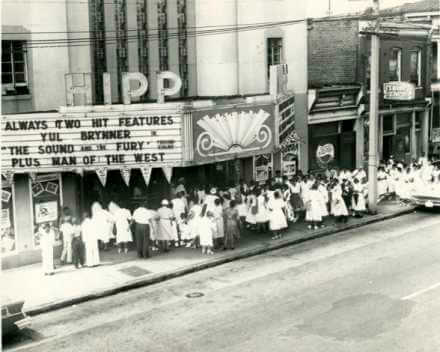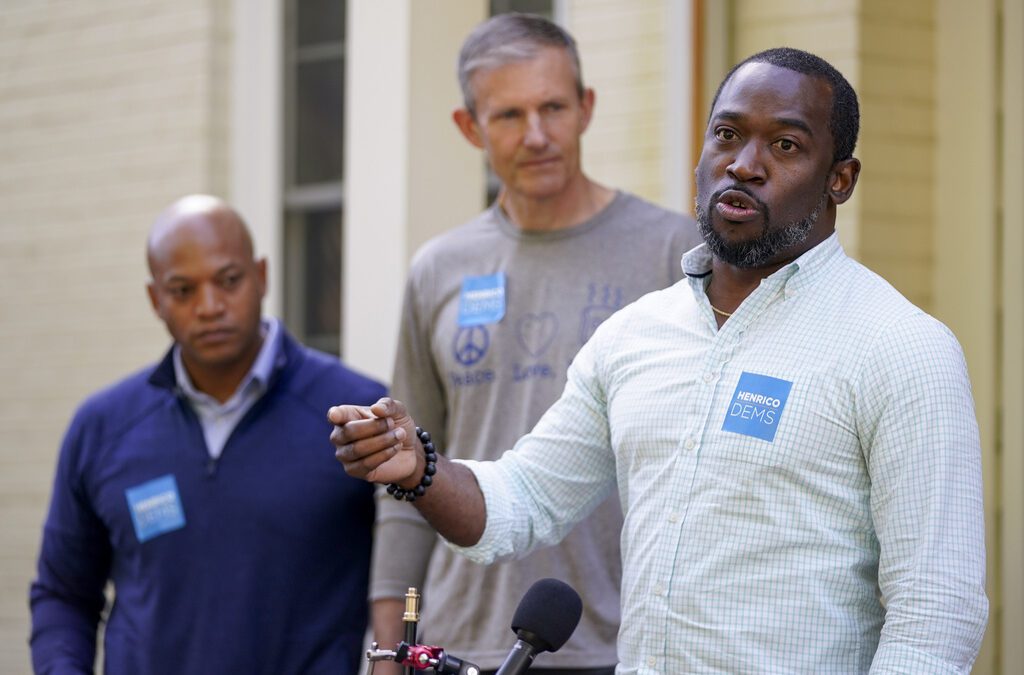
A look at the Hippodrome in 1959, when people lined up to see "The Sound and the Fury."
What caused an area known across the country to change over the years?
RICHMOND- What do you know about Jackson Ward? Most people living in the city of Richmond know the names Robert E. Lee, Stonewall Jackson and JEB Stuart. But what about the names of other Virginians like Maggie L. Walker or Bill “Bojangles” Robinson?
They, along side several other Black Virginians, were responsible for transforming Reconstruction-era Richmond into the birthplace for Black entrepreneurship.
For decades before the Civil War, Richmond was the country’s center for selling and torture of enslaved Black people. But after the war ended, these newly emancipated people came together and created a thriving community for Black people by Black people.
In response to Jim Crow laws barring them from other businesses, Black people took it upon themselves to create their own.
Eventually by the 1920s, people called Jackson Ward the “Harlem of the South”. At the time, they compared it to the city in New York that was experiencing a similar renaissance in Black culture.
But, due to racially discriminatory laws and business practices, Jackson Ward eventually crumbled into disrepair and poverty by the 1940s. Now, the district’s Black residents are still suffering from the aftershock of these racist actions to this day.
History of Jackson Ward
The Civil War left Virginia extremely segregated, especially Richmond. Not only was Richmond the capitol of the state, it was also the capitol of the Confederacy. In response to the abolishment of slavery, many states put Jim Crow laws in place to keep Black people oppressed. This included restricting where minorities could live.
Black residents took action, creating Jackson Ward in 1871.
“Jackson Ward kind of started rising up after the end of the Civil War,” said Hippodrome Theater owner Ronald Stallings. “It became an enclave for free Blacks, Italians, Jews and other immigrants to live where they weren’t as disenfranchised from the overall economic revitalization that came in after reconstruction.”
Historian Carol Brown described Jackson Ward as a city within a city. Out of necessity, Black people had to create their own banks, restaurants and other businesses because they weren’t allowed to go to whites only establishments.
“The white insurance companies, most of them, would not insure black people. So they formed their own little societies. They saved money in these societies. And when someone became ill, there would be money that could be used for purchasing medication and what not. When someone died, there would be money for that person’s burial,” Brown said in a VOA story.
In 1905, Maggie L. Walker made history as the first woman bank president. She founded Consolidated Bank & Trust, the oldest surviving black-operated bank in the United States. Their main branch is still located in Jackson Ward at 1st and Marshall Streets.
The Hippodrome
But Jackson Ward wasn’t just a place for businesses. During the early 1900s to 1920s, it was the most musical place past the Mason Dixon line. Famous performers from across the country would come to Richmond to perform or even just hang out the many clubs in the area.
And when Jackson Ward was the Harlem of the South, the Hippodrome was its crown jewel. Opened in 1914 by a vaudeville performer, originally only Black people could attend the theater. Because of the deeply segregated South, The Hippodrome was a safe haven for Black patrons and performers.
“Theaters, stores, banks, all sorts of different things popped up in Jackson Ward,” said Stallings. “In 1914, the Hippodrome was built for black people. So it was wasn’t built for the general public. It was built to serve that particular community.”
In its heyday, the Hippodrome saw world-famous, jazz artists like pianist Duke Ellington and singer Ella Fitzgerald. According to Stallings, even Cab Calloway would frequent the club after performing at whites-only venues.
Unfortunately, after a fire in 1945, the Hippodrome was closed for numerous years. But, the club reopened in 1966, under James Russell Stallings’ ownership. It was important to him that this piece of Richmond history was preserved. Now, Stalling’s son carries on his legacy, keeping the Hippodrome open.
“My dad got it. I didn’t get it while I was growing up, but he understood that the buildings were the minor monuments to people’s alive came before,” said Stallings. “If you preserve the building, it’s much easier to tell the history of what these people accomplished. “
There have also been other efforts to preserve the legacy of Jackson Ward. The city built statues of Jackson Ward legends like Walker and legendary tap dancer Bill “Bojangles” Robinson. There’s also a national historic site dedicated to Walker in Jackson Ward.
Redlining and Gentrification
It’s a common misconception that Jackson Ward’s downfall was a byproduct of integration. Books in the 1960s and 1970s claim that when white businesses began to allow Black patrons, that Black businesses began to suffer.
But historians argue that there might’ve been more malicious reasons behind Jackson Ward’s economic decline. According to Bruce Mitchell, a senior analyst at the National Community Reinvestment Coalition, the concept of redlining is to blame.
In 1937, the Home Owners Loan Corporation created Residential Security Maps that would determine which neighborhoods were worth investing in. The system that ran off a four part grading system. You graded a neighborhood with either an A, B, C and D. The higher their grade, the easier it was to receive a loan.
If the HOLC gave the area a “D”, they’d also outline the neighborhood in red, hence the term “redlining”. Usually, these neighborhoods were predominantly Black, like Jackson Ward.
“We do find African-American neighborhoods [were often] graded as hazardous by the examiners,” said Mitchell. “And the case in of Jackson Ward, it was 95% African-American in the area.”
And unfortunately, this redlining created a permanent stain on the district. Even to this day, Jackson Ward has been fighting against that hazardous label. But without proper investment, it’s been an uphill battle for the district’s improvement. Now, many of these redlined areas are facing gentrification today.
How Gentrification Effects Jackson Ward Today
Right now, the people of Jackson Ward face another problem: the issue of gentrification. So far, NCRC has done two reports of gentrification in the area- one from 2000 to 2010 and the other from 2010 to 2017.
“(Richmond) is experiencing high amounts of gentrification for a city its size. One area that we noted that is gentrifying would be that area of Jackson Ward,” said Mitchell.
Now, gentrification is a hot button word. However, according to Mitchell, it’s not always a bad thing. Usually, when an area begins to gentrify, the overall quality of living improves. But, the problem comes in when the people who originally lived there can’t enjoy the benefits of gentrification.
Oftentimes when an area is gentrified, current residents get pushed out. As the cost of living increases, they can no longer afford to stay there anymore.
“And as a consequence of (gentrification), you do find that there has been displacement in Jackson where the African-American community has been displaced a large matter within that area,” said Mitchell.
Mitchell says cities like Richmond need to involve their residents in the development process to prevent things like this from happening.
“It’s very important that cities reach out to resident neighborhoods and find ways that they can facilitate residents to remain within those neighborhoods perfectly through implementation of things like affordable housing,” said Mitchell. “So there needs to be a much greater involvement on the part of the cities and developers with the existing.”
JOIN THE CONVERSATION: Sign Up For Dogwood’s Daily Newsletter
The State of Jackson Ward Today
In terms of gentrification, there are several grassroots organizations fighting on the front lines. Virginia Local Initiative Support Corporation has been fighting for housing equity in Richmond for 29 years. Now, they’re offering
There are plenty Black-owned businesses still running and operating around the district. New restaurants like Soul Taco are still open in Jackson Ward, while older classics like the Croaker Spot have relocated to Manchester.
The Hippodrome itself is still open and ready for business. Due to COVID-19, Stallings had to change some of their usual operations. But, they’re still open and accepting customers.
Located on 528 N 2nd St, its doors are open from 11 a.m. to 3 p.m. on Saturdays and Sundays. On those days, you can traditional breakfast foods, like eggs and bacon, alongside Southern classics like chicken and waffles. They also feature martinis named after Black entertainers and icons, like Cab Calloway, Duke Ellington and Maggie Walker.
You can also book the Hippodrome for private events from Monday to Friday.
Arianna Coghill is a content producer for the Dogwood. You can reach her at [email protected]
Politics

Biden administration bans noncompete clauses for workers
The Federal Trade Commission (FTC) voted on Tuesday to ban noncompete agreements—those pesky clauses that employers often force their workers to...

Democratic shakeup in Virginia primaries for governor, lieutenant governor
Richmond Mayor Levar Stoney quit his bid for governor and jumped into the race to be the Democratic nominee for lieutenant governor. The race for...
Local News

The zodiac signs of 12 iconic women offer insight into their historic accomplishments
Zodiac signs can tell you a lot about someone’s personality. Whether they’re an earth, water, air, or fire sign, these 12 categories (which are...

Virginia verses: Celebrating 5 poetic icons for National Poetry Month
There’s no shortage of great writers when it comes to our commonwealth. From the haunting verses of Edgar Allan Poe, who found solace in Richmond's...




